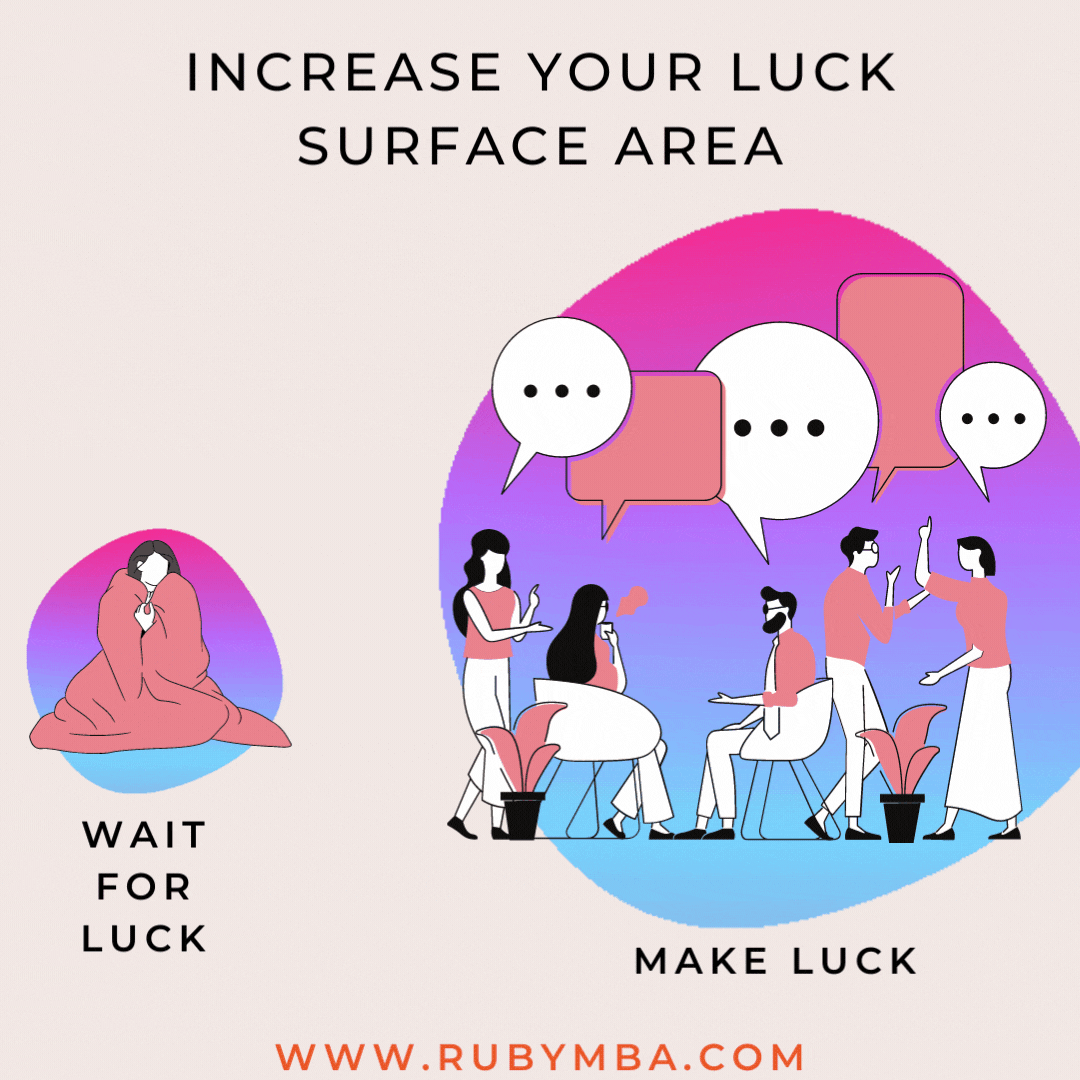It happens to all of us. We can get so bogged down in the day to day of business delivery that we lose focus on business growth. Sometimes, business delivery is our comfort zone, and we just hope and pray that business growth takes care of itself.
Note: A business very, very, very seldom grows without focused effort.
I love process and formula. Getting clear on actionable steps helps to dissolve resistance, procrastination, and fear. It’s when we’re not sure what to do next that we flounder and often avoid doing anything.
Today’s playbook demystifies the steps to business growth. There are only 5 levers that you need to pull in your business to positively impact your bottom line.
I’ll topline these in today’s playbook, and we will deep-dive in future articles.
This is also a topic that we cover in our Masterclasses and in our Group Coaching sessions.
Let’s jump into today’s Playbook: The 5 Levers (to 3X Profit) Playbook
When looking at your bottom line, profits are the result of having more income than expenses.
This means that we need to focus on ways to increase income, and ways to reduce or contain expenses. If we get these two right, we will increase our profit. If we get one of these right (either increase revenue, or reduce expenses) while being consistent with the other, we will also increase profits, but to a lesser extent.
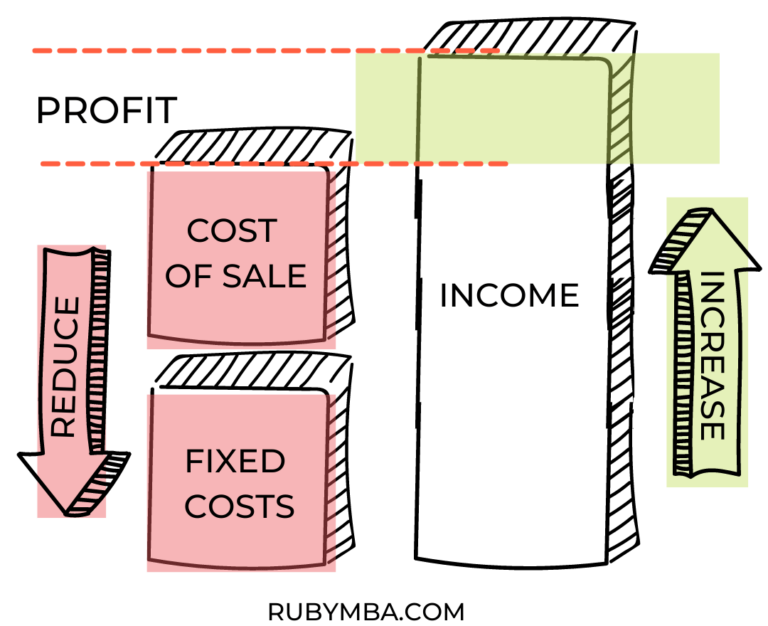
Everything we do at RubyMBA is designed to support you to increase your revenue. In our one-on-one coaching sessions, we also delve deep into the second aspect – reducing costs.
There are 4 levers that you can pull to increase revenue. The fifth lever is focused on reducing costs.
The first thing to do is to establish your base across these levers.
We’ve created a Google Spreadsheet for you to enter your current numbers into (make sure to save it as an editable version before using).
For our example below (see green inputs)
- I’ve assumed that this company gets 300 leads per month.
- They convert 10% into customers, resulting in 30 clients.
- Each customer spends an average of 1,000 per sale.
- Customers tend to make one purchase over the 1 month period (i.e. 1 sale per client).
- This results in 30,000 in revenue.
- They have 10,000 in fixed costs (rent, salaries etc) and 20% cost of sale (the cost of producing the product).
- This results in 14,000 profit for the month.
Let’s look at each of the Levers
1st LEVER - LEADS
A lead is a business or person who shows interest in buying your offer.
They exchange some information, like an email address or other form of contact information, to show interest.
They may make an enquiry, they may sign up for a free offer.
Lead Generation is a deep topic. We delve more deeply into it in our Masterclasses and group programmes. There are many lead generation strategies, from running an advertising campaign on TV (expensive), right down to cold calling, where you call up people that you think will buy and tell them about your offer (not much fun at all).
I’ll focus on one free, digital strategy today.
Step 1a of successful lead gen is to get as specific as possible about who is most likely to buy your product.
Step 1b: Understand what their pain is, why are they looking to buy? If you haven’t watched ‘Master Your Messaging’ yet – videos 3 – 5 will help you clarify this.
Step 2: Once you know who is most likely to buy, you need to find out where they like to hang out. This could be facebook groups, they could follow certain experts on twitter, they could be reading certain newsletters etc.
Step 3a: Get in front of these pre-built communities by engaging and offering valuable insight and support.
Step 3b: Build a relationship with the owners of the groups and newsletters. These relationships are great for reaching their audience with their blessing. Some ways to leverage this relationship would be to have your offer promoted in their newsletters, to be interviewed on their podcast, or having your article published on their site.
Step 4: Now, a contact on a social media platform is great, but it’s not really your lead until you have direct access to them. The best way to do this is to give them something of value in exchange for their contact details. This can be through running a competition or other promotion. Generally an interested person is willing to give you their contact details in exchange for some useful information. This is called a lead magnet or optin freebie.
Step 5: Promote your optin freebie (which is directly related to your offer) in exchange for their contact details. You now have a cost free strategy to grow your leads.
If everything in your business remains the same, and the only change is that you implement a lead generation strategy to increase your leads by 10%, you will see an increase in your profits.
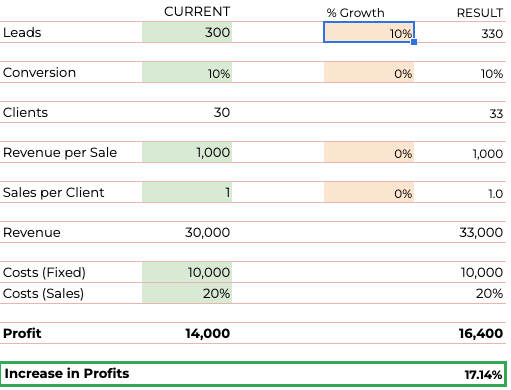
In our example, by increasing leads from 300 to 330, we achieve a 17% increase in profits!
2nd LEVER - CONVERSIONS
The next lever to pull is your lead conversion. This is the rate that you are able to get leads to become paying customers. If 4 people enquire, and 1 buys, you have a conversion rate of 25%
Do you remember playing that game where someone is trying to find a hidden object, and you would yell out COLD, or WARMER or HOT depending on how close they were to the object?
Your sales funnel will have colder leads and warmer leads. Colder leads are people who are sort-of interested but not yet ready to buy. Warm and then hot leads are much closer to making a buying decision.
As with Lead Gen, this is an extensive topic.
TOFU (TOP Of the FUNNEL)
People at the top of your funnel have just begun to think about buying, they’re still doing research on exactly what they need (the Job that they need To Be Done), is it in their budget, what other options can help them to solve their challenge.
They might not know anything about your brand.
At this point you want to help them to decide whether the offering that you have will solve their Job To Be Done. And you want to start to build some brand awareness of your business, so that they begin to know you.
- Your email nurture sequence and your freebies can help to move them from Cold to Warm.
- Educate about the broader solution generously and possibly entertain.
For example, they may be thinking about beautifying their outdoor space. You offer wooden decking. They really don’t know what they want yet. Give them loads of outdoor decor ideas at this point – don’t just push decking benefits onto them.
MOFU (MIDDLE Of the FUNNEL)
(Yes I know! Who makes this stuff up!!)
Potential customers who are getting warmer, have decided that the type of product or service you offer might solve their JTBD. They’re now comparing your offer to your competitors, or to an entirely different solution that has also made the short list.
For example – their JTBD is that now that they are working from home, they feel bad that they barely move out of their home office chair ALL-DAY-LONG, and then the only exercise they get is the loong walk from their home office to their kitchen and then to the couch! They are looking for a way to ease their conscience, without changing into a complete fitness bunny.
You might offer yoga classes, and they’re considering a few Yoga Shala’s near their home. They might also be looking at home fitness equipment, like a stationary bike, or all in one gym.
- At this point, you want to highlight the benefits of yoga in general, and highlight what is really special about your yoga classes.
- Testimonials, short how to video excerpts from your classes.
- It’s not time for a hard sell, although an invitation to a free open day could work well.
And then, you guessed it, or did you? BOFU (BOTTOM Of the FUNNEL)
As your leads move down the funnel i.e. get clearer that your offer might be their solution, they also thin out. There may be 100 leads at the TOFU stage, and now you’re down to 20 people who are pretty sure that they might buy from you.
- At this point they want more real information about your offer. The yoga school should be giving times of classes and prices.
- This is also the time where a special offer can swing the deal.
‘Three months is the shortest amount of time that it takes to know if yoga is for you. This month only buy three months and only pay for two!’ - All along this journey, you want to share generously, so that they have a really good understanding of your offer.
- Sharing also taps into several Mental Triggers, like Reciprocity (where they have a slight feeling of obligation to give something back to you) and building Authority (where they start to understand your expertise and to trust you as an authority in your field.
If you implemented some of these sales funnel strategies into your business, do you think it would improve your conversion rate? Uh, yes! Let’s assume a conservative 10% improvement in conversions.
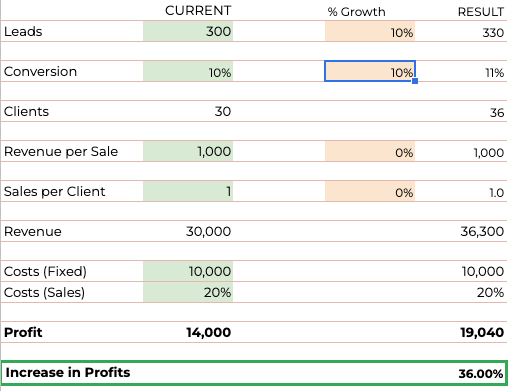
By increasing our conversion rate by 10% (from 10% to 11%) we add to our lead gen improvements.
Profits are now 36% up since implementing these extra digital elements.
3rd LEVER - REVENUE PER SALE
Exactly as it sounds, this is the average amount that a client spends with you per purchase. If you have varying prices, you could take the total number of sales for the period, and divide that into the sales revenue generated over that period. this will give you the average revenue per sale.
Because I’m a human, before I’m a business coach, I struggle a little with suggesting price increases. But I must.
Many small businesses have failed to differentiate themselves from their competitors and so end up having ‘lowest price’ as their only differentiator. This is a beastly place to be in.
Yes, you are likely to lose some clients when increasing your prices, but even a 10% loss in clients (which is extreme) compared to a 5% increase in prices can result in increased revenue for your business.
There is also a percentage of clients that will spend more with you if you just give them a chance.
If you haven’t already, can you build some upsells into your offering? Where can you create additional value that will better serve your new client, if they have the budget?
The motor vehicle industry are brilliant at this:
By saying yes to the most expensive item (the car), we see all the upsells as super cheap in comparison – the tinted windows, the paint protective shield, the bump and scratch insurance, scotchguard on the seats etc etc. And so they increase the average revenue per sale.
If you consciously build these opportunities upfront, you will be more easily able to increase revenue per sale.
There are many strategies to increase the average revenue per client, which we will deep dive later in the year. I hope that this has you thinking!
See what you can bundle to increase revenue per sale, can you build in some upsells. How will this improve your revenue per sale? Pop this % into your Google Sheet and assess the impact.
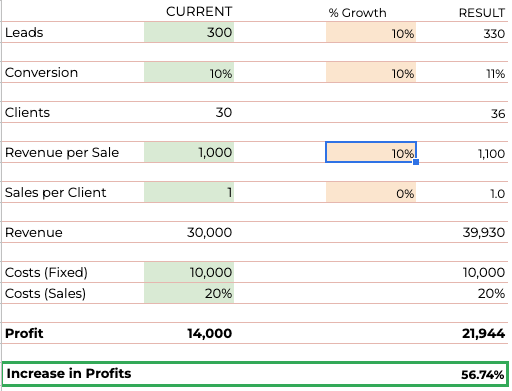
From 36% up to 56% increase in profits, when we focus on increasing our revenue per sale by just 10%.
4th LEVER - SALES PER CUSTOMER
If you can increase the number of times that a customer buys from you in a given cycle, you will improve your bottom line.
So many businesses make a sale and then ignore their customer.
The plumber, the pool guy, the hairdresser. Very few businesses keep the love flowing after the sale.
It is much easier to get a happy client to spend again with you than it is to get a brand new client to spend with you.
The stats vary but we can comfortably say at least 8 times easier.
Build a customer retention strategy that you or your team implement after each sale.
Really understand why the customer bought from you, what Job To Be Done the customer was hiring for.
Use this information to build products and services that better support your clients needs. Amazon is constantly updating their offerings based on what their customers want, giving their customers reasons to buy and buy again.
Build a communication strategy that really shows your customer what’s in it for them.
Don’t waste too much time on showcasing how fabulous you are, rather show them how you solve their challenges.
Our wooden decking company could share that several decking clients have been asking which indigenous trees best compliment the decking. And they have organised a 20% saving from a local indigenous tree supplier just for their decking clients, along with some giant tree pots that the decking company now supplies.
Always be interrogating and solving your business gaps to better serve your customers.
Look at building partnerships with aligned businesses so that you can offer a more comprehensive experience.
Our Yoga Teacher could partner with a Tea Ceremony facilitator to offer a half day ‘Into the Zen’ experience.
Where are you cutting off your relationship with your customers? Where and how can you deepen that relationship further?
How much could you increase the number of times a client buys from you, with the right customer retention and love strategies? In our example we’re looking at a 10% increase in number of purchases per cycle. Yes, we’re being conservative.
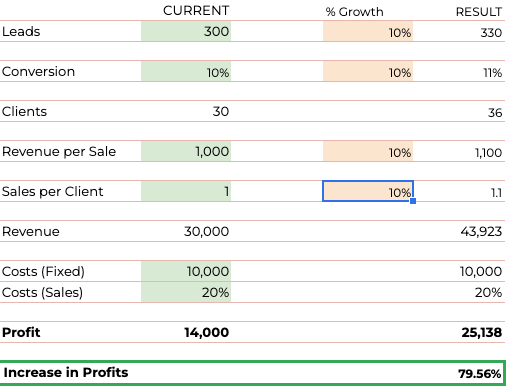
If we can get our clients to buy an average of 1.1 times (10% up on only 1 time per cycle) we again increase our profits.
In our example, we have managed to increase our profit potential by 79% by implementing one or two strategies per lever.
5th LEVER - REDUCE COSTS
Reducing costs is the only lever that is not related to marketing but rather related to running an efficient business.
The three areas to focus on for business efficiency are Time, Team and Money.
As much as these may not directly reduce costs, they improve efficiency, which reduces costs.
If you team was taking 3 weeks to process orders, and you are able to streamline this to 7 working days, you have managed to reduce costs.
At RubyMBA, we only work with clients on the fifth lever in our one on one coaching programmes, as each aspect is dependant on working closely with leadership to understand the company’s unique challenges and then to implement relevant solutions.
Broadly – TIME includes:
Assessing which roles and responsibilities the leader can delegate to a junior or outsource to a Virtual Assistant, thereby freeing them up to drive strategy and possibly marketing.
Developing an apprenticeship plan so that leadership can efficiently pass on responsibilities in a way that ensures successful handover and implementation.
As your company grows an Operations and Training Toolkit is vital so that onboarding and role clarity becomes efficient.
TEAM includes:
All aspects that build a team that can work well together, from implementing a one page strategic plan so that everyone in your team is aligned to your business goals, a KPI system, a performance incentive system, a Leadership development plan through to running efficient meetings.
If these aspects appeal to you, a worthy read is The Rockefeller Habits by Verne Harnish.
MONEY includes:
A breakeven plan where process is assessed, and all bloat is trimmed, a revenue and profit budget, a sales strategy plan, a cash gap plan to improve collections and lengthen terms with vendors. And so much more!
As this is outside of marketing and sales, and involves a bespoke approach we won’t look at possible results (which can be staggeringly high)!
Each of the levers take some work.
Don’t try to do everything at once. It makes sense to focus on implementing strategies from one lever for at least one quarter, before adding focus on a second lever.
Each strategy that you implement needs to be built, implemented, assessed, tweaked and rolled out again, as you learn what works best for your ideal customers and clients.



